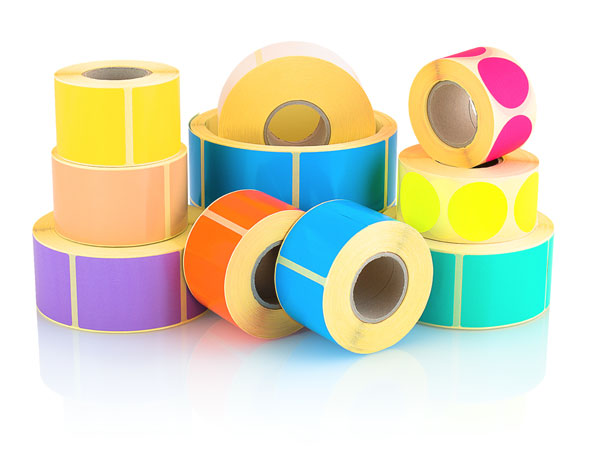Considerations When Buying Labels
Adhesives
Latex-Free - Natural rubber latex is made from plant sources such as the sap of the Brazilian rubber tree. Repeated exposure can result in sensitivity to natural rubber latex proteins, with symptoms ranging from skin redness, rash, hives or itching to difficulty breathing and wheezing. Rarely, shock and even death can occur. UAL labels are not made with natural rubber latex adhesives.
Permanent and Extra Permanent - Permanent adhesives will tear or pull fiber when removal is attempted from paper after label is allowed to set. Some hard-to-label surfaces such as certain plastics may require more aggressive adhesives called extra permanent.
Removable - If a tape or label needs to be removed from an object after use, removable adhesive is the best choice. Pay special attention to the amount of time between application and removal, and whether “no residue” is an absolute must after long-term use.
Ultra-Removable - These adhesives adhere to smooth surfaces and remove cleanly. UAL has special proprietary ultra-removable adhesive called Clean Tac, designed for long term removability/repositionability from various surfaces without leaving a residue.
Application Temperature - The temperature at which your label will be applied is called the application temperature. If your surface is frozen, you will want a freezer-grade label. Pay particular attention to items that need to wrap onto frozen surfaces as this needs a good combination of freezer-grade adhesive and flexible face stock that can handle the curves.
Service Temperature - The highest and lowest temperatures your label will be exposed to during use is the service temperature. Special attention should be given to extreme temperatures such as those found in cryogenic and autoclaving applications. For example, cryogenic is an often-used term used to request a label for extreme cold. Knowing that your label needs to go down to dry ice temperature of -80°C rather than liquid nitrogen temperature of -196°C will ensure you get the right adhesive without paying for an extreme that you don't need.
Service Temperature - The highest and lowest temperatures your label will be exposed to during use is the service temperature. Special attention should be given to extreme temperatures such as those found in cryogenic and autoclaving applications. For example, cryogenic is an often-used term used to request a label for extreme cold. Knowing that your label needs to go down to dry ice temperature of -80°C rather than liquid nitrogen temperature of -196°C will ensure you get the right adhesive without paying for an extreme that you don't need.
Face Stocks
Coated Paper - Coated paper is generally very smooth and is more resistant to dirt, moisture and wear. Depending on the coating, these can be matte, semi-gloss or gloss.
Direct Thermal Paper - Creates a printed image by selectively heating the thermal paper as it passes over the thermal print head of the printer. The coating turns black in the areas where it is heated, producing an image. Direct thermal papers do not require a ribbon. This type of printing is not recommended for items that must be stored for more than a few months, or will be exposed to sunlight, UV lights or heat.
EDP Paper - Very economical general-purpose uncoated material that works well for address labels, distribution and pin-fed/dot-matrix labels. The finish is typically rougher than coated papers. If labels will be exposed to chemicals or water consider synthetic or adding a laminate.
Flexible Paper - These types of papers are combined with synthetic latex to create a label that conforms better to curves than regular paper. Flexible paper is recommended for labels that go on vials, syringes, tubing, etc.
Fluorescent Paper - This brightly colored uncoated stock is available in yellow, red, green, pink, and orange. It's useful when a paper label needs to stand out.
Foil-like Paper - Aggressive adhesive and metallic sheen make this a great choice for equipment labeling or for creating an elegant look on packaging and mailings.
Laser Paper - Laser paper is made to specifically work with laser printers, and it is also suited for use with office equipment such as fax machines and copiers. Laser sheets may also be made from synthetic materials, which are best for moist environments or exposure to water.
Synthetic Vinyl - Ideal when the label will be exposed to the elements. Perfect for signage and bumper stickers.
Synthetic Polypropylene -Designed for indoor use when you need durability against chemicals and water-resistance. Often used for equipment labeling and decorative packaging applications due to its flexibility. It is a cost-effective alternative to vinyl when outdoor use is not needed.
Thermal Transfer Paper - Thermal transfer printing uses a heat-sensitive ribbon to put the image onto coated paper. Thermal transfer is better suited than direct thermal for printed items that must be stored for more than 2 months. The ribbon ink will not fade in sunlight or heat. Remember the ribbon must be matched to material to achieve maximum burn onto the label material.
Thermal Transfer Paper - Thermal transfer printing uses a heat-sensitive ribbon to put the image onto coated paper. Thermal transfer is better suited than direct thermal for printed items that must be stored for more than 2 months. The ribbon ink will not fade in sunlight or heat. Remember the ribbon must be matched to material to achieve maximum burn onto the label material.
Varnishes & Laminates
Laminate - A thin layer of clear material applied on top of a label during manufacturing that provides superior protection against moisture, chemicals, oils, smudging, and wear. Some labels offer this built-in lamination as an added feature.
Gloss Varnish - Topcoat provides glossy finish and added durability to the label.
Matte Varnish - Topcoat provides matte finish and added durability to the label.
Note: When a varnish or laminate is applied you may lose the ability to write on top of the label. Please ask if a writable top-coat can be applied if that need is required.
